Space and Time
"Winding your way along Kromdraai Road, Sun(w)hole (2019) pops in and out of view. From a distance the artwork is recognisably man-made: the top corner juts out from the hillside like a sundial, its silhouette stark against a crisp, winter sky. In summer the rain clouds gather, reaching outward and upward before spilling their contents across its weatherbeaten surface. Amine El Gotaibi’s intervention has become something of a talking point at FARMHOUSE58, visible as it is from different vistas. It shifts with you as you move, like a giant revolving door. People on hikes are drawn to the work, uncertain about what it is or why it’s there. Most linger on the hole at its centre, unable to see anything through it but sky." (Sven Christian, A Place to Daydream. In: FORM Journal, Issue 1: “Time”. Villa-Legodi Centre for Sculpture - South Africa, 2023. p. 57)
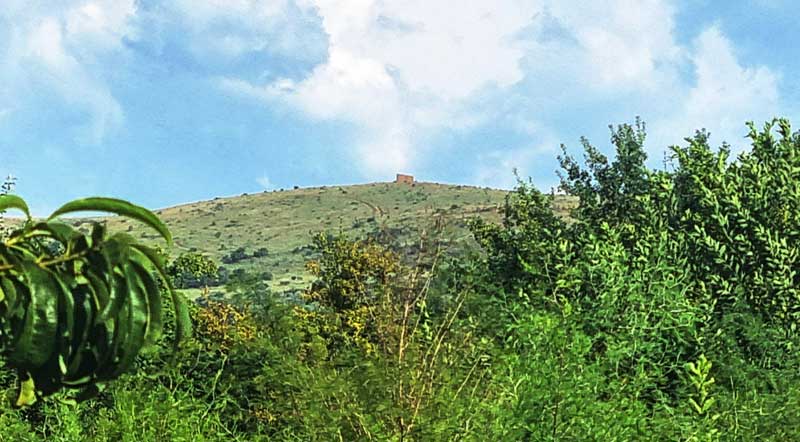
Amine El Gotaibi, Sun(w)hole - Piece of cradle 1, 2019. Rammed earth, 1530 x 60 x 400 cm. FARMHOUSE 58, Cradle of Humankind, South Africa (Photo: Ernst Wagner)
All images of the artwork with the permission of the artist.
In February 2024, the EVC "Textbook Working Group" met at Nirox Farmhouse near Johannesburg, South Africa. Colleagues from South Africa, Ghana and Germany took part. One early morning, all participants went on a hike to this work by Amine El Gotaibi. A joint writing process afterwards led to an intensive discussion on how such a work of art can be understood from different perspectives shaped by disciplines and backgrounds.
Nicole Berner, Friedrich-Alexander-University Nuremberg, Germany
One step after the other. A long path, stones and grass, the heat is tough. The artwork rises like a wall in the middle of the landscape on a hill. At first it seems strange in the middle of the green landscape. A rectangular object, several metres long. You can see into the sky through a round hole in the centre. From a distance, it is a brown mark and it is unclear what material it is made of. Then we get closer. The material is known. The artwork is made of earth and stones, like the path we came. Different coloured stones and earth are baked together. They divide the landscape. Now there are two sides. A shady side and a sunny side. The only thing connecting the two sides is the sky through the hole. The surface of the artwork is smooth and rough at the same time. Smooth due to the pressing of the earth, rough in the areas where wind and rain have already eroded it.
- How long will the artwork be there?
- Which side do I want to be on?
- What boundary is drawn here?
- What separates the two sides?
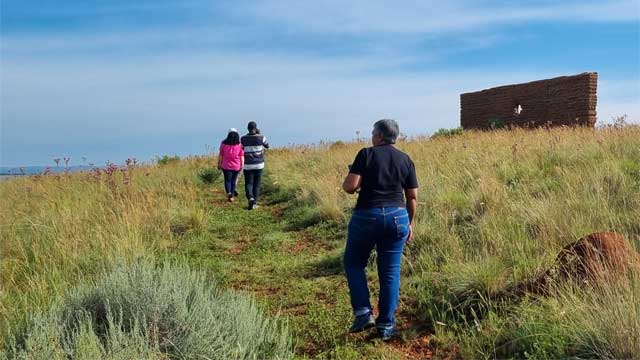
Visitors approaching El Gotaibi's Sun(w)hole, February 2024 (Photo Ernst Wagner)
Avi Sooful, University of Pretoria, South Africa
(W)Hole in the African Wall
The journey to view an artwork that sits on top of a hill as a shrine, a physical wall made of blocks and sand pebbles that carried a hole in its structure. This structure was both physical and metaphorical extending beyond the space that it occupied. The textured surface eroded over time was welcoming and abrasive at the same time. One wonders about the intention of the work, why a rectangle, why a hole? The struggle to hold meaning that ascribes to the thoughts of the artist confronts the viewer, the rigidity of the shape is limiting yet the hole allows for the extension of the whole through the hole thus becoming a marriage of the sky and the land. It allows the wall to breathe and yet suffocates you with its resistance to being acknowledged as something specific.
In responding to a question by a colleague, how does this affect the lives of South African people, the answer is simple in that it does not. It remains a gigantic rectangle on a hill, far removed from the all-seeing eye. How does this relate to the world, a wall in the middle of nowhere with a beginning and an end that owns its shape and size that offers no particular story yet includes all stories.
As an artist, I enjoyed the visual and the commonplace, hole in a wall that one is often exposed to when water or sky meets land. The violence that exists that hides behind beauty, I reference violence as embedded in the wall, the rough surfaces that seek to protect an inner sanctuary. The violence that it took to mix the sand and pebbles, the spade grating against the surface of the land when mixing the ingredients and then forcing this into a frame to create a block that grew into the rectangular structure. A block within a block. The human sweat and thoughts that remain figments of the structure’s experience when constructed allow for the real and the unreal to meet, like the initiated thoughts that trespassed through my mind.
Philipp Schramm, University of Bayreuth / Iwalewahouse, Germany
In the southeast of Farmhouse58, some 20 minutes uphill to the top of a softly curved mound, the narrow path leads to a men-built structure, which at first sight seems to be the remains of a historical building, the ruins of a shed or a farmhouse. It consists of a single wall, approximately eight meters in width, about four meters in height, and around 0.4 meters thick. The wall has an evenly leveled top, so it was not designed as a kind of gable wall. Right in the middle, there is an oculus, a circular window with a diameter of 70 cm, at a height of approximately 2.5 m. Approaching the wall, you’ll find out that it was constructed in several compartments of rammed earth. There are six vertical sections still reconstructable with the seam of the mud structure and several vertical layers, each approximately with a height of 25 to 30 cm, hinting at the shape of the mold box used in the construction.
Rammed earth buildings are not unusual in southern Africa when it comes to historical buildings. But this monument is not a historical testimony. It was drafted and executed as an object of contemporary art. The artist, a man from Morocco, used the language of traditional house building techniques to create a new meaning that does not comprise the idea of a shed or a manor but the idea of a monument. The location, situated in a wonderful landscape of smooth green hills and peaceful pastures, is essential for this monument, which incorporates by definition the idea of land art. Like Robert Smithson's huge spirals, it corresponds with the surroundings, and to place it on the top of a hill so it appears to be a kind of ruined wall at first, is an intended resemblance.
As the wall has now stood there for almost five years, time has already left some traces. The surface of the wall has been washed out by the rain, and the stones and particles of the earth are loosening. It is obvious that this monument has not been designed to stay for eternity. The concept of perishability is inherent. The oculus opens the simple structure to a wide range of interpretations. An oculus itself is often used in special buildings like chapels or noble manors. This window opens to the east, so the sun in the morning or in the evening is welcomed. Is there a distinct meaning to this wall? There are no direct hints. But the herders and the wanderers will be happy about some shelter from the sun and wind. And they also will follow their own ideas about the meaning of this structure.
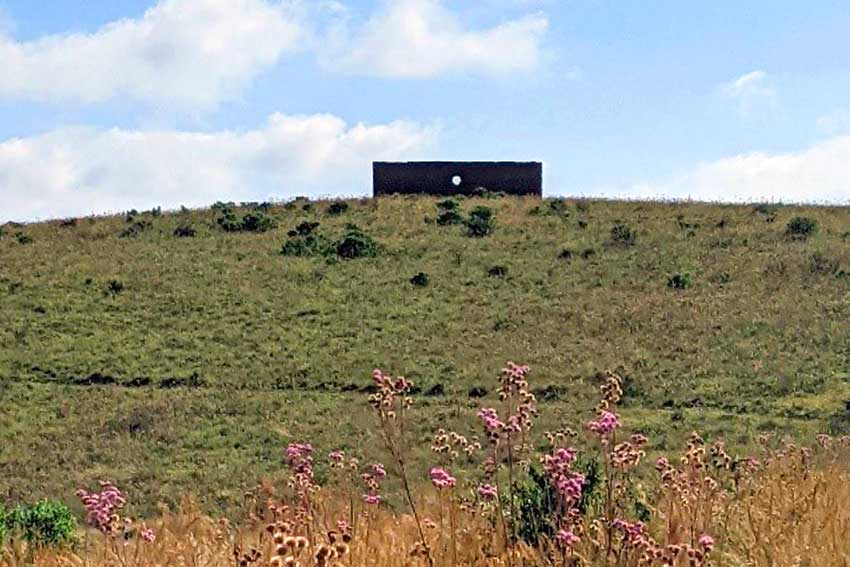
Amine El Gotaibi, Sun(w)hole - Piece of cradle 1, 2019 (Photo: Nicole Berner)
Esther Yeboah Danso-Wiredu, Department of Geography Education, University of Education, Winneba (UEW), Ghana
I will look at the hole in a wall geographically from a weak point by which environmental forces such as erosion, weathering can act faster. So a holistic wall will be very difficult to break because the forces will first have to create a weak point before it starts eating into the entire wall. But with this hole in a wall, it makes it easier for the environmental forces to find a beginning point quickly to destroy the entire wall faster. Again the materials used to make the wall seem loose, so it can easily become a fertile ground for agents of denudation to destroy it quickly.
I also noticed that one part of the wall looks smooth and strong whilst the other part seems weak. In geography, we say the one that is weakened faces the windward side, whilst the other smooth side faces the leeward side. This means, anytime it rains or the wind blows, the windward side faces it and hence, there is more pressure on that side to be weakened as it is clearly showing now. Furthermore, the wall is made up of different sediments. Anytime, the agents of denudation hits on it, the softer materials erode, so gradually all the soft ones will go, creating several lose joints for the building to collapse eventually.
In terms of human geography, the layers created in the wall, representing the African continent and the boarders between countries can give rise to distinct cultural characteristics, with each country showcasing its worth. I believe, we can however, harness on the cultural differences which can be depicted from the different materials used for the wall to weave one strong creative Africa, made up of different people, languages, culture etc.
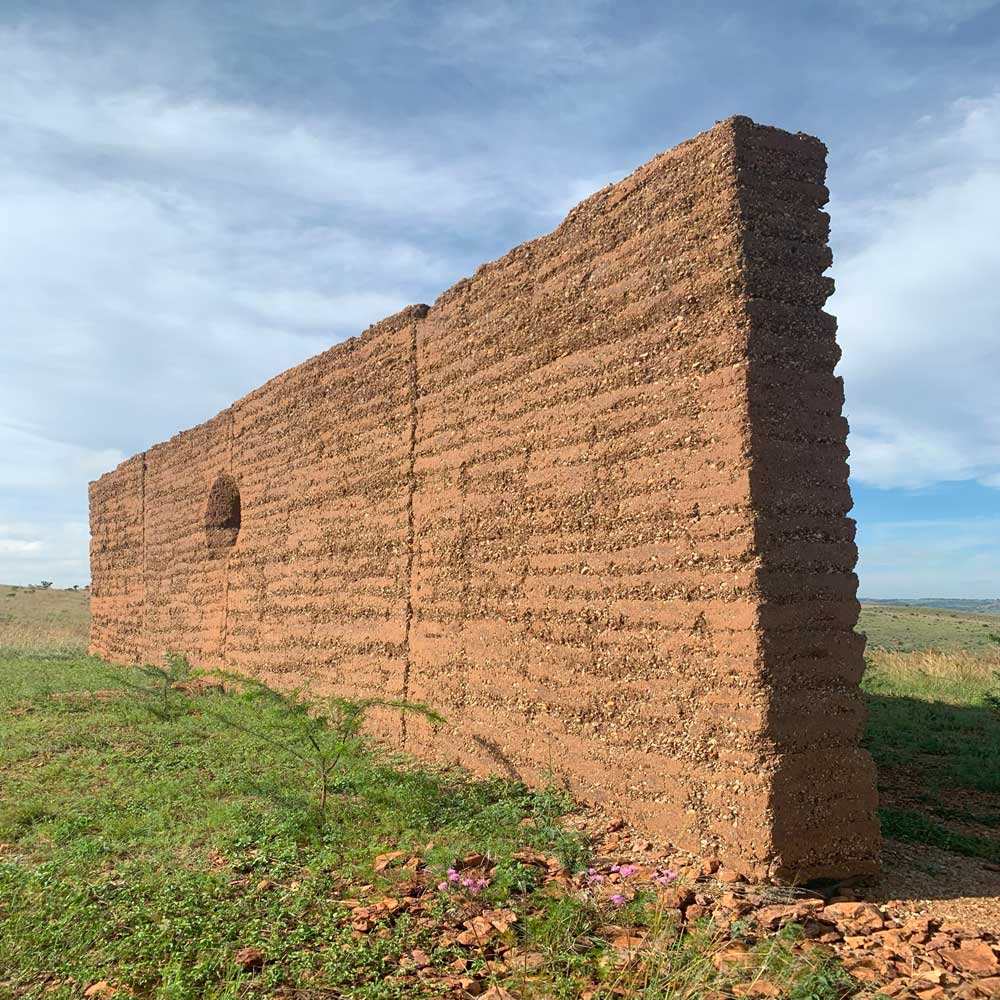
Amine El Gotaibi, Sun(w)hole - Piece of cradle 1, 2019 (Photo: Patrique deGraft-Yankson)
Ernst Wagner, Munich, Germany
On the top of a very lonely hill in a beautiful South African landscape, the work impresses as a sign that raises questions without answering them. It is made using an ancient Moroccan manufacturing technique (tamped, untreated earth from the place where it stands). Like many contemporary works of art, it deals with questions of sustainability and the relationship between human beings and nature / the cosmos. It grows out of its location and will disappear again without a trace. With its reference to the sky (and the sun), it has an almost sacred character. When we walk around it, we have the opportunity to ask questions about our relationship to the earth, the sky and the sun. Like many contemporary works of art, this work opens up a space for this experience.
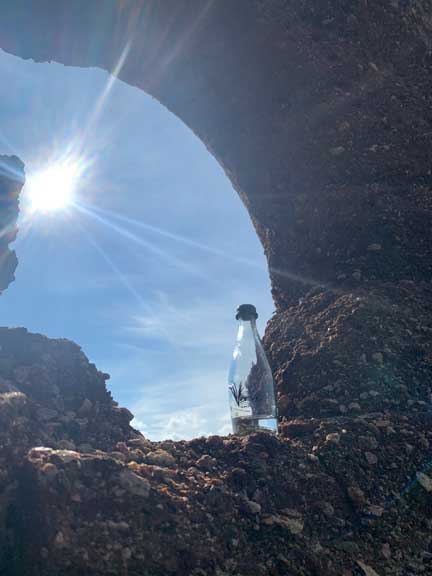
Amine El Gotaibi, Sun(w)hole - Piece of cradle 1, 2019 (Photo: Patrique deGraft-Yankson)
Patrique deGraft-Yankson, Department of Art Education, University of Education, Winneba (UEW), Ghana
My encounter with the wall transported me down memory lane to my early adolescent years when I was sent to one of my uncles in one of Ghana’s remotest villages, after my father’s demise. This was in the late 1970s when rural living was synonymous with poverty and deprivation. Despite that, I found a lot of fascination in rural life and was particularly enthralled by their sense of communal living and love for one another. I observed a community where people supported each other in practically everything they did. They took turns tending to colleagues' and relatives’ farms, and, most importantly, I became particularly enthused by how they came together to support each other in building shelters. Almost the entire community would unite to support anyone wanting to build a house, especially newly married men. These houses were constructed with thatch and clay from the environment. Once the location of the house was identified and the grounds prepared, the community would come out of their houses to help dig the foundation and prepare the clay. The structure of the building would involve hard wood taken from the forest, cut into required sizes, and fixed together with specially chosen creeping stems from the forest, serving as ropes. These buildings took one to two weeks to complete.
After listening to the story about the wall narrated by our tour guide, especially concerning the brain behind its construction, my mind was cast back to how local communities in my uncle’s village joined hands to build for a common purpose. The construction of those houses, like the construction of the wall, was characterized by several minor to major accidents and incidents, but builders always stayed resolute to finish, no matter what. The intention for the construction of the wall, which is to unite people rather than set boundaries, could be likened to the spirit of togetherness that characterizes the construction of houses in my uncle’s village community. In other words, not every wall is built to divide.
From a distance, Amine El Gotaibi’s massive, rigid wall, titled Sun(W)hole, stands alone on elevated ground, creating an astonishing yet discordant presence in the hilly ambiance. It appears foreign to the naturally arranged shrubbery and obstructs the free flow of air and movement in the area. However, upon closer inspection, a conspicuously large opening in the top-middle portion of the wall breaks its rigidity and clumsiness. This opening transforms the wall into a more interactive structure, allowing not only the free flow of light and air but also facilitating the seamless sharing and transfer of scenery and objects.
In today's complex society, human-constructed political, religious, and racial walls seem to foster division. But were these barriers truly erected to separate, or were they, like the buildings in my uncle's village, constructed for shelter and to celebrate the beauty of differences? The answer lies in recognizing the beauty of diversity. While we may create walls, it is essential to incorporate openings that unite us. Even amidst divergent opinions, diversity should serve as the foundation for constructing socially beneficial structures rather than being used as tools for division. In this way, long after the fragility of life, as symbolized by the weakness of the soil used to build the wall, succumbs to mortality, we will remain bound together by the boundless human spirit that knows no boundaries.
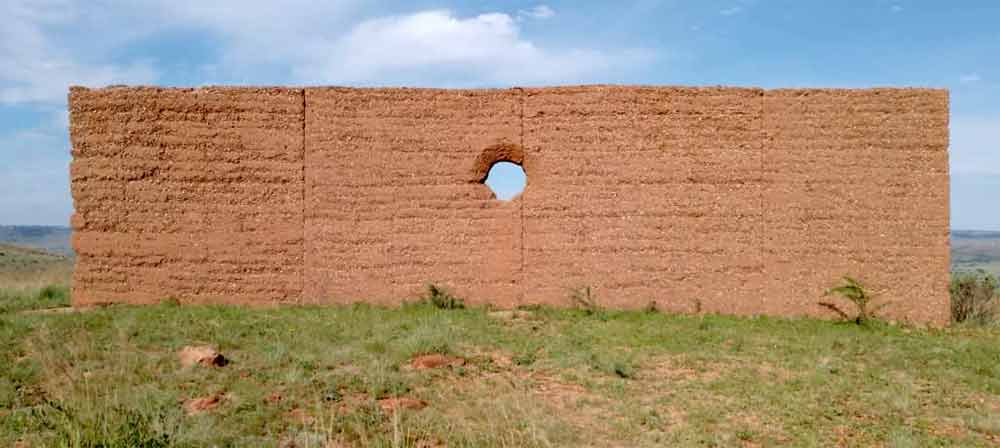
Amine El Gotaibi, Sun(w)hole - Piece of cradle 1, 2019 (Photo: Osuanyi Quaicoo Essel)
Osuanyi Quaicoo Essel, Department of Art Education, University of Education, Winneba (UEW), Ghana
Amine EL Gotaibi’s monumental sculpture located at Farmhouse, Johannesburg in South Africa seems to hinge on the painful contemporary realities of deep territorial and sub-regional divisions that have characterized the African continent as a result of colonization. The divisions have created a seemingly impenetrable boundary yielding to the divide and rule concept used as colonialist weaponry to capture and share the territories of Africa.
In giving an artistic impression of the regional divisionism obstructive to building united Africa where there is free movement of people in a way that it boosts trade, political, social and economic cohesion, Gotaibi metaphorically sculptured a gigantic wall composed of mud and pebbles with circular whole positioned at the middle portion of the entire wall. The pile of mud used in fabricating the wall creates implied horizontal linearity from the base to the topmost part. The precariousness of the mud material gives rise to occasional disintegration and fall to the ground which the artist likened to the boundaries created by systemic structures and colonialism such as apartheid, xenophobia and neocolonialism that inhibit unity of Africa. Through this work, the artist brings to the fore these issues and possibly yearns for an end to it for a better and united Africa.
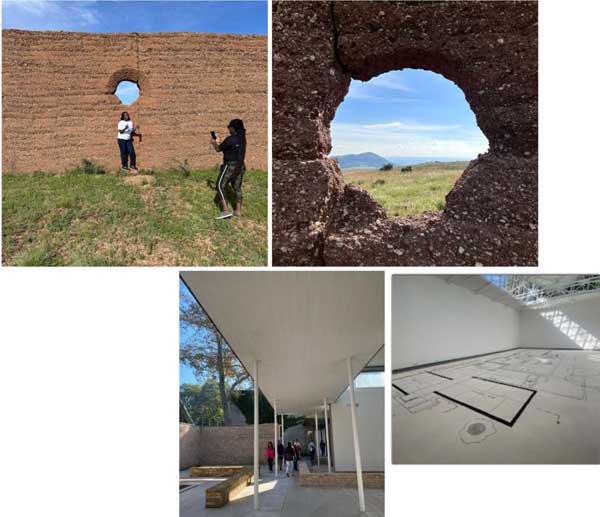
Amine El Gotaibi, Sun(w)hole - Piece of cradle 1, 2019 (Photos: Cristian Römmelt)
Christian Römmel, LMU Munich, Germany
A wall in the landscape. It describes a border. Land on one side, land on the other. He gives the wall four years, then it will be gone, says our guide. The material is slowly being eroded by wind and rain. Boundless land as a promise for the future. I look through the hole in the middle: Far away in another country, Morocco, there is a second wall, I learn. The missing piece of wall connects.
The wall itself is located in a defined piece of land. To what extent does art that is only accessible to a limited number of people help to change social reality? Where is there room for our own experience of exclusion? Osuyani asks whether it is art for art's sake. Drawing boundaries, excluding.
Tearing down borders, making borders disappear. What changes? Do new relationships emerge? Karin Sander and Philip Ursprung experiment artistically with this question and tear down a wall of the Swiss pavilion at the last Architecture Biennale, which it shares with the pavilion of Venezuela. Crossing borders from one national pavilion to the other becomes possible without having to pass through the respective entrance first. The architects write: “We are rethinking the function of the two pavilions and their surroundings, dissolving their boundaries with artistic means. In this way, we question spatial, cultural and political boundaries as well as conventions of national representation.”
For them, it is a planned process, deliberately brought about. The floor plan bears witness to this. The future of the Moroccan artist's wall is uncertain. When will wind and water erode the wall? Will it be slowly eroded or will it collapse at some point? Let's see what happens...
Gertrude Nkrumah, Department of History Education. U.E.W, Winneba, Ghana
I was first intrigued by the art work at my initial observation. It triggered several questions for me. For example, I was curious to know why this piece exists in what may be considered the middle of nowhere, what is the motivation behind the creation of this art work and what does it seek to achieve? Upon some explanation and further clarification from the tour guide I came to some general and specific conclusions. My observation of the sun (w)hole connotes a sense of life’s adversities that afflicts humans in diverse unsurmountable ways and yet provides a leeway to overcome such adversaries in life despite boundaries. Challenges may be inevitable in life, yet it behooves on individuals to find ways of overcoming such difficulties. These maybe artificial/man-made or natural setbacks, yet there is the possibility of overcoming these challenges, and that is the hope that the hole in the wall represents. The hope of seeing ahead, looking beyond these challenges and overcoming the boundaries created, and forge ahead into the future with renewed and positive outlook of life. The vastness of the wall in comparison to the limited/small size of the hole in the wall at first glance paints a gloomy or pessimistic picture. Yet a careful and closer observation gives one a sense of optimism. The hope that there is still an outlook, a view beyond the boundaries set by the vastness of the wall. That gradually, the imposing wall can be dismantled so that it no longer becomes an obstacle in the way.
The challenges, the setbacks, may represent social, economic, and political challenges in the general sense. Specifically, these could be economic and social barriers brought about by poverty, lack of education, among others. Politically, setbacks such as political divisions or political issues seen as very sensitive and controversial that present a huge impediment in the society. In Africa, the hole in the wall can connect with the question of colonialism and colonial impositions and the new forms of colonialism – neocolonialism. Historically, colonialism in Africa left behind unsurmountable, colonial artificial boundaries both visible and invisible – such as acculturation, territorial and language barriers - that continue to portend setbacks. The vastness of the wall represents the enormity of these existing visible and invisible structure. Nonetheless, the hole serves as a source of hope to gradually overcome and dismantle these imposing wall-like structures. The solution to overcoming the problem is a gradual, consistent effort, one that seeks to expand the hole in the wall and eventually breakdown the wall.

Amine El Gotaibi, Sun(w)hole - Piece of cradle 1, 2019 (Transition zone from the wall to the ground. Photo Ernst Wagner)
Christiane Schmidt-Maiwald, Augsburg University
When I first saw the work of art enthroned on a hill from afar, I perceived it as a ruined castle; although at the same time I realized that it was simply a piece of wall with a hole in the middle. The closer we got, the less sure I was whether I liked this kind of intervention in this wonderful landscape. To me, it seemed imposing and insensitive in the midst of the delicately graduated colors of nature. To be honest, the work seemed to me to fit in particularly well with the resort's well-designed world - with its natural material like many of the other works of art on the property – without any further deeper meaning. I saw no political approach and no real connection to the surrounding nature. Above all, I had the impression of a stereotypical work of art created according to Western premises that had been transplanted into the landscape. The artwork did not inspire me to think further, but rather blocked my curiosity – perhaps because I had already seen so many variations of this type of artwork at biennials and art fairs. I was only willing to engage with the artwork a little more when Osuanyi shared his views with us – probably because I had a similar impression that this was a typical example of the Western understanding of art for art's sake.
Of course, a political statement could be interpreted in the meaning of a piece of wall, but that would be very banal. I was also not convinced by the following explanations of the origins and the two different sides. Unfortunately, that sounds very negative. I was probably just too impressed by the tranquillity and beauty of the landscape and not mentally ready for a critical art discourse. However, such a subjective experience can certainly be helpful in order to better understand how children, young people or even adults who grow up away from art sometimes feel about hermetic artworks
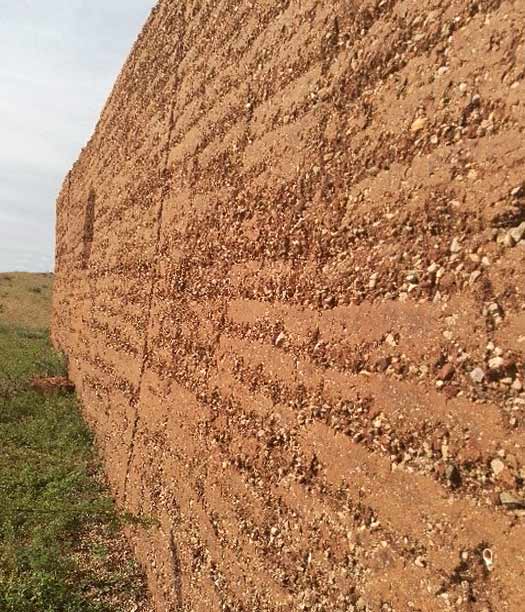
Amine El Gotaibi, Sun(w)hole - Piece of cradle 1, 2019 (Photo: Ebenezer Acquah)
Ebenezer Acquah, Department of Art Education, University of Education, Winneba (UEW), Ghana
My first impression about the sight of Sun(w)hole - Piece of cradle was an isolated brick architectural monumental work, perhaps designed to get the viewer to contemplate on why the creation and mounting of this visual cultural work in an isolated location. I had the impression that it was part of an abandoned house but a close view of it revealed its other interpretations. The work shows a brick wall in dark red colour that has been affected by the weather conditions with time, thus exposing diverse sizes and shapes of small pieces of stones in different colours. In addition, this rectangular-block architectural monument exhibits a horizontal layering that explains the method applied in building the structure. The work is situated on a hill in a grassland with patches of shrubs and small trees.
The entire work is segmented into four parts, with a thin vertical line separating each section. Except for the first section of the wall, the other three sections are virtually of the same size. The hole is created at the upper part of the second section of the wall at the extreme end, though a little bit of it is in the third part. The work is reminiscent of struggles of countryside dwellers in deprived communities whose sweat sometimes leaves traces of neglect through the ages. In spite of their harsh economic situations, they stubbornly cling together, only to be separated by unforeseen circumstances that are beyond their control. The connection or bond of the people is seen through the small pieces of stone and mud that were used perhaps as a binding agent in the work.
The hole found in the wall gives an impression of escape route in spite of the harsh economic conditions that confront the people. But the size of the outlet limits the number of people who can take advantage of the opportunity to migrate to other places and seek perhaps freedom/liberation. Upon a deep reflection of this work, I view it as a form of visual culture that tells the story of connectivity, diversity, migration, and a quest for liberation.
Published March 2024
